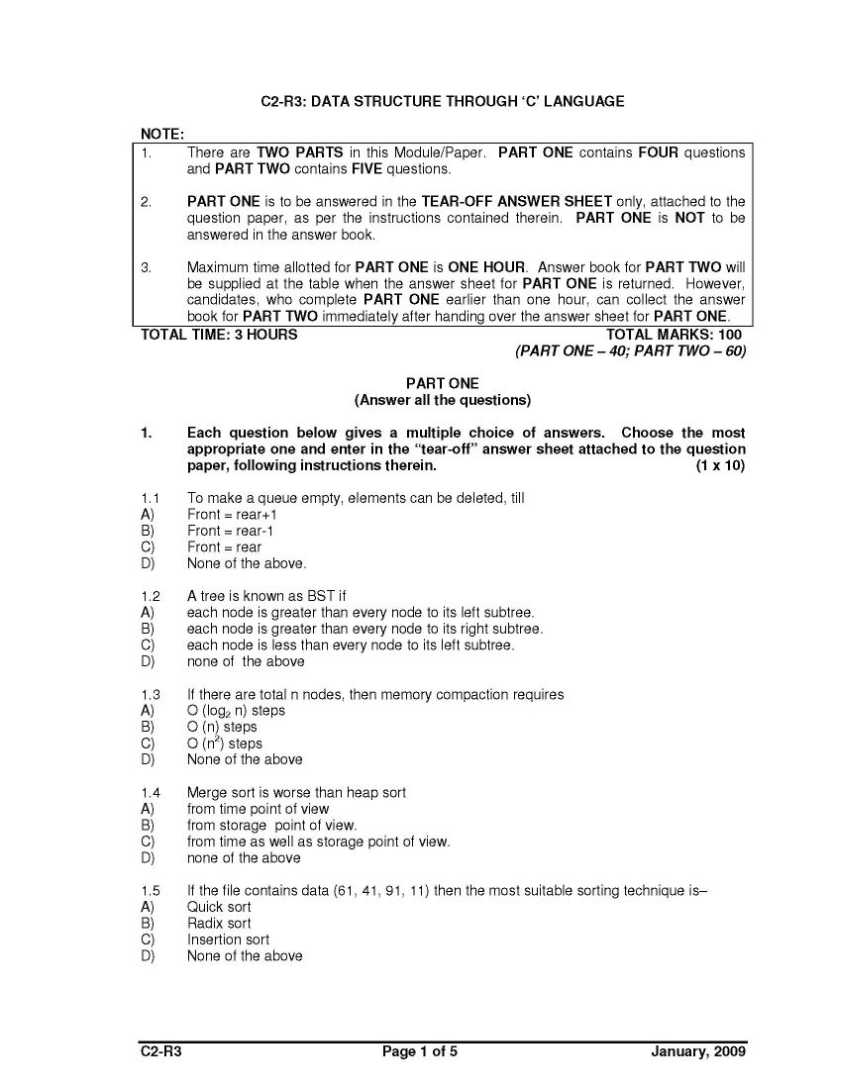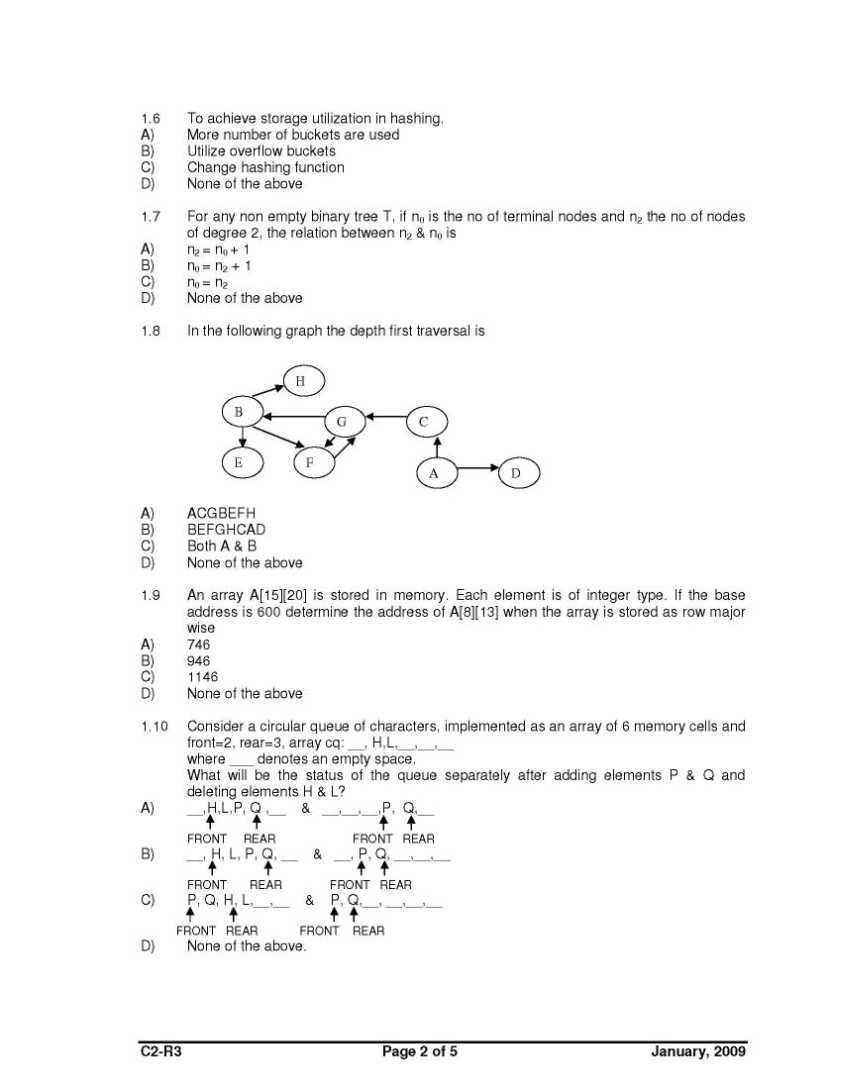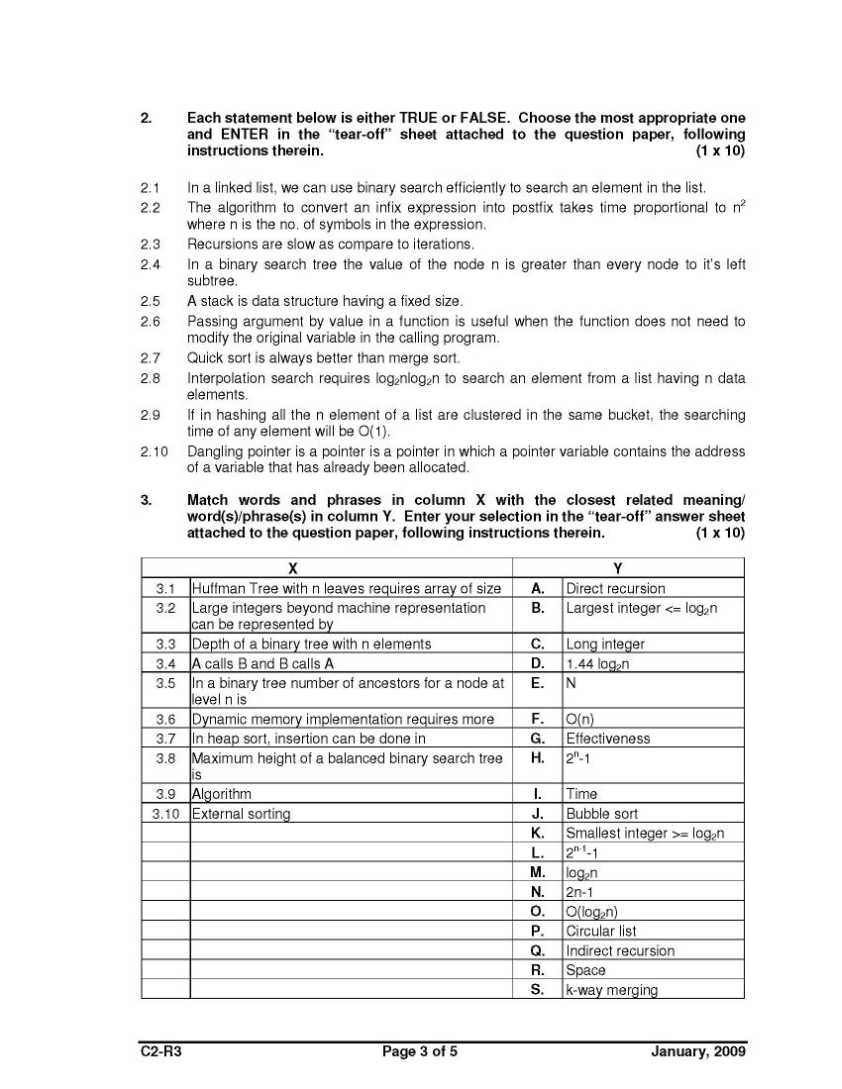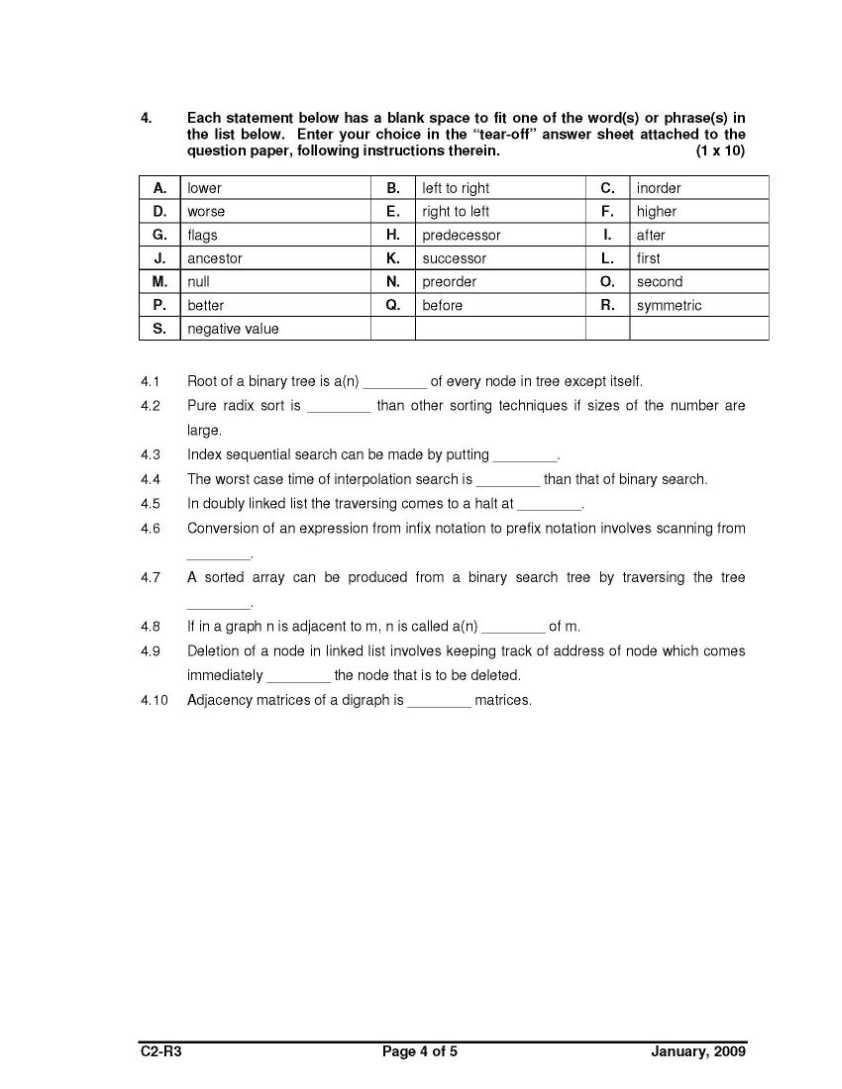|
#1
| |||
| |||
|
Can you please give me the DOEACC C Level Course Data Structure through C Language previous years question papers as it is very urgent for me?
|
|
#2
| |||
| |||
|
As you want to get the DOEACC C Level Course Data Structure through C Language previous years question papers so here is the information of the same for you: Some content of the file has been given here: 1.1. Adjacency matrix for a digraph is A) Unit Matrix B) Symmetric Matrix C) Asymmetric matrix D) none of the above 1.2. Time complexity of insertion sort algorithm in the best case is A) O(n) B) O(n log2 n) C) O(n2) D) none of the above 1.3. The prefix expression for the infix expression a * ( b + c ) /e - f is A) /* a + bc – ef B) -/ * + abc ef C) - / * a + bcef D) none of the above 1.4. In linked list representation, a node contains at least A) node address field, data field B) node number, data field C) next address field, information field D) none of the above 1.5. Number of nods in a complete binary tree of depth k is A) 2k B) 2k C) 2k-1 D) none of the above 1.6. The smallest number of keys that will force a B-Tree of order 3 to have a height 3 is: A) 12 B) 10 C) 7 D) none of the above 1.7. Given two sorted lists of size “m” and “n” respectively, the number of comparisons needed in the worst case by the merge sort will be: A) m*n B) max(m,n) C) min(m.n) D) m + n – 1 1.8 Any string of bits of length n represents a unique non-negative integer between A) 0 and 2n-1 -1 B) 0 and 2n-1 C) 1 and 2n-1 D) none of the above 1.9 Which of the following expressions accesses the (i,j)th entry of a m n matrix stored in a column major form ? A) m * ( i –1 ) + j B) m * ( j –1 ) + i C) m * ( n – j ) + i D) m * ( m – i ) + j 1.10 The following sequence of operation is performed on a stack push(1), push (2), pop, push(1), push(2), pop, pop, pop, push(2), pop. The sequences of popped out values are A) 2, 2, 1, 2, 1 B) 2, 2, 1, 1, 2 C) 2, 1, 2, 2, 1 D) 2, 1, 2, 2, 2     For more detailed information I am uploading PDF files which are free download: Contact Details: National Institute of Electronics and Information Technology Electronics Niketan, 6 CGO Complex, Jawaharlal Nehru Stadium Marg, CGO Complex, Pragati Vihar, New Delhi, Delhi 110003 011 2436 3330 India Map Location:
__________________ Answered By StudyChaCha Member |
|
#4
| |||
| |||
|
Here I am providing you DOEACC C Level Course Data Structure through C Language previous years question paper; please have a look……. DOEACC C Level Course Data Structure through C Language previous years question paper 1. Each question below gives a multiple choice of answers. Choose the most appropriate one and enter in the “tear-off” answer sheet attached to the question paper, following instructions therein. (1 x 10) 1.1 “p” is a pointer to the structure. A member “mem” of that structure is referenced by A) *p.mem B) (*p).mem C) *(p.mem) D) None of the above 1.2 Which one is not correct? A) Pointers are used for dynamically allocating memory. B) Dynamic memory allocation is preferred when storage requirement is not predictable. C) Data access in dynamically allocated storage is faster than static allocated storage. D) None of the above 1.3 Which of the following cannot be performed recursively? A) Binary Search B) Quick Sort C) Depth First Search D) None of the above 1.4 Which of the following types of expression does not require precedence rules for evaluation? A) Fully parenthesized infix expression B) Original Prefix expression C) Partially parenthesized infix expression D) None of the above 1.5 In a binary tree, the number of terminal or leaf nodes is 10. The number of nodes with two children is: A) 9 B) 11 C) 15 D) 12 1.6 Which of the following is a hash function? A) Quadratic Probing B) Chaining C) Open addressing D) Folding 1.7 If the inorder and preorder traversal of a binary tree are D, B, F, E, G, H, A, C and A, B, D, E, F, G, H, C respectively then, the postorder traversal of that tree is : A) D, F, G, A, B, C, H, E B) F, H, D, G, E, B, C, A C) C, G, H, F, E D, B, A D) D, F, H, G, E, B, C, A 1.8 Which of the following is not correct? A) f(n) = O (f(n)) B) c*f(n) = O (f(n)) for a constant c C) O (f(n) + g (n)) = f(n) + O (g (n)) D) O (f(n)2) = O (f(n))2 1.9 Given 2 sorted lists of size “m” and “n” respectively. The number of comparisons needed in the worst case by merge sort will be A) Min (m, n) B) m*n C) m + n –1 D) Max ( m, n) 1.10 A B-tree of order m is an m-way tree in which all internal nodes except the root have at most now empty children A) m-1 B) m C) 2 m D) 2 m 2. Each statement below is either TRUE or FALSE. Choose the most appropriate one and ENTER in the “tear-off” sheet attached to the question paper, following instructions therein. (1 x 10) 2.1 Introducing interfaces can help to eliminate dependences. 2.2 Sequence diagram is a tool used to depict the sequence and variation of screens. 2.3 De-referencing operator * has the same effect when it is applied to a pointer, a structure or a union. 2.4 In an empty threaded binary tree the right link of the head is a thread to itself. 2.5 Array is linear data structure. 2.6 Insertion in and deletion from an array does not involve physical movement of elements of the arrays. 2.7 The adjacency matrix corresponding to a graph consisting of “n” nodes but no edges is a unit matrix. 2.8 Recursion cannot be removed without using a stack. 2.9 If an AVL tree has n items then its height is log n. 2.10The average sequential successful search time for a sequential file having “n” records is (n+1)/2. 3. Match words and phrases in column X with the closest related meaning/ word(s)/phrase(s) in column Y. Enter your selection in the “tear-off” answer sheet attached to the question paper, following instructions therein. (1 x 10) X Y 3.1 Circular list A. Data structure for backtracking 3.2 Pointer B. Height Balanced Trees 3.3 Forest C. Static Tree Table 3.4 Tree D. Collision Resolution 3.5 Pendant vertex E. Most sparse AVL Tree 3.6 AVL Trees F. Dynamic Environment 3.7 Rehashing G. Pattern Matching 3.8 Fibonacci Tree H. Shell Sort 3.9 Finite Automata I. Used in Sparse Matrix 3.10 Divide and Conquer J. Ordered set of ordered trees K. Merge Sort L. Dynamic Data Structure M. A Vertex with degree 1 4. Each statement below has a blank space to fit one of the word(s) or phrase(s) in the list below. Enter your choice in the “tear-off” answer sheet attached to the question paper, following instructions therein. (1 x 10) A. Log2n B. Floor (log2 (n) +1) C. Floor ( log2 (n + 1)) D. n-1 E. N F. Faster G. Slower H. Less than I. More than J. 3 K. 2 L. Queue M. Stack N. Many - to - many O. One-to-many P. Storage Structure Q. Non recursive R. recursive 4.1 Time complexity of inserting an element in a heap of “n” elements is of the order of ________. 4.2 Best fit approach is generally ________ than first fit approach for memory allocation. 4.3 Representation of data structure in memory is known as ________. 4.4 A graph represents ________ relationship between nodes. 4.5 The depth of a complete binary tree with ‘n’ nodes is ________. 4.6 A tree is a cycle free undirected graph with n vertices and ________ edges. 4.7 Space required to store an adjancy matrix is ________ that to store the adjancy list of a dense graph. 4.8 Number of positions where the second largest elements of a heap may be stored is ________. 4.9 Conversion of infix arithmetic expression to postfix expression requires the use of ________. 4.10 The minimum number of edges in a connected cyclic graph of ‘n’ vertices is ________. (Answer any FOUR questions) 5. a) If A(n) = am nm + am –1 nm -1 + -------------- + a1n + a0 is a polynomial of degree n, then show that A(n) = O (nm), where O stands for big – oh notation. b) Write a ‘C’ function to add two polynomials using arrays. (7+8) 6. a) Consider a linked list with a pointer pointing to its head. Write a ‘C’ function to insert a node to the front of the list, after the last node, in between the list. b) Write a ‘C’ function to copy one stack to another assuming the stack is implemented using linked list. (7+8) 7. a) Write a ‘C’ function to count the number of nodes in a binary tree. b) What do you mean by height balanced binary search tree? Write the steps for converting a general binary search tree into a height balanced tree. c) Prove that a binary tree with n internal nodes has (n+1) external nodes. (5+5+5) 8. a) Create a B-tree of order 5, when the keys arrive in the following order a, f, g, b, k, d, m, j, e, s, i, x, r, y, c b) Create a binary search tree when the elements arrive in the following order 10, 5, 20, 7, 29, 11, 23, 29, 13, 12 c) What do you mean by threaded binary tree? Give an example. (8+5+2) 9. a) What do you mean by a spanning tree? Create a minimal spanning tree for the following: 15 16 18 10 20 12 17 20 25 b) Write a C function for bubble sort. Hence, giving intermediate lists, sort the following: 11, 10, 12, 8
__________________ Answered By StudyChaCha Member |